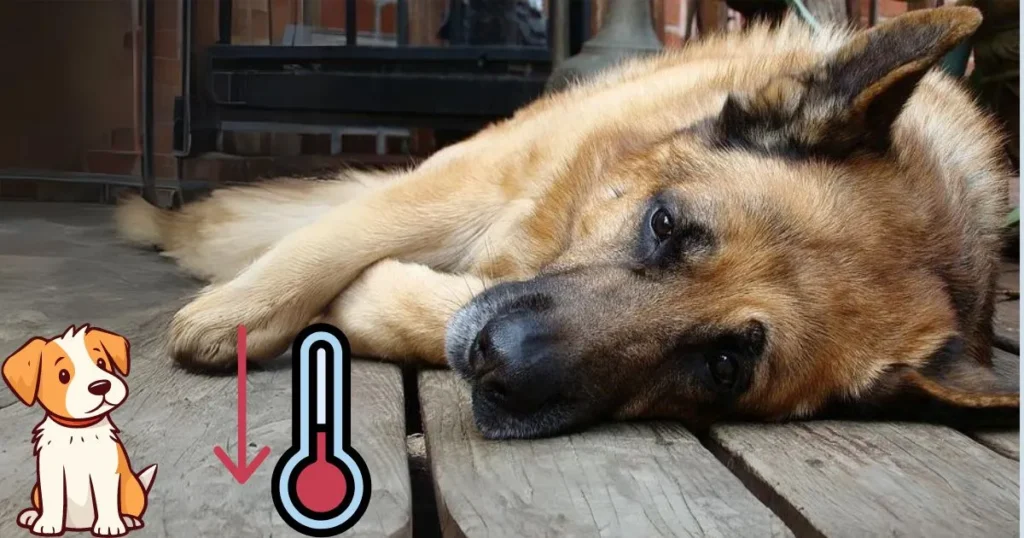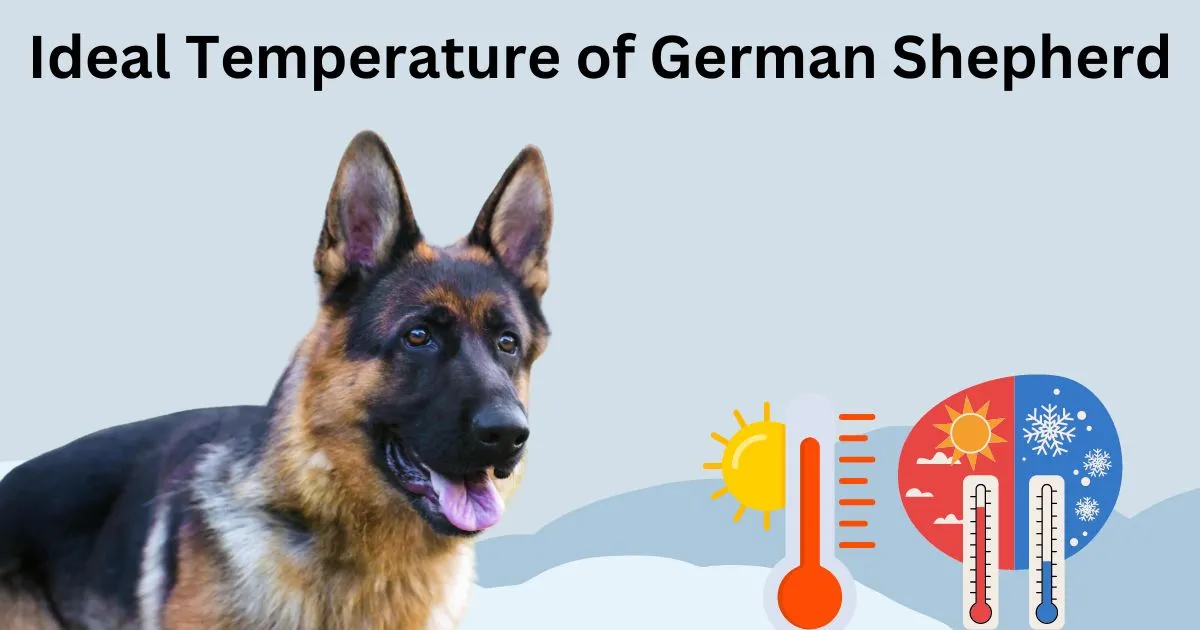What is the ideal temperature of a German Shepherd puppy?
As responsible pet owners, it is essential to provide them with a comfortable environment that promotes their overall well-being. In this article, we will explore the ideal temperature range for German Shepherd puppies, highlighting the significance of maintaining a suitable climate for their health and happiness in hot and cold weather.
The ideal temperature range for a German Shepherd puppy is between 65°F and 75°F (18°C and 24°C). This range ensures that the puppies are neither too hot nor too cold, allowing them to grow, play, and rest without any discomfort.
65°F – 75°F (18°C – 24°C) Ideal temperature range for German Shepherd puppies. Above 80°F (27°C) Risk of heatstroke and dehydration. Below 40°F (7°C) Risk of hypothermia and frostbite.
It is important to monitor the temperature and make adjustments to maintain a suitable environment for your puppy’s development.
Heat or Chill? Understanding the Temperature Needs of Your Growing German Shepherd

In hot weather: The ideal temperature range for German Shepherds in hot weather is between 70°F and 85°F (21°C – 29°C). Provide shade, and ample water, and avoid leaving them in direct sunlight for extended periods.
In cold weather: German Shepherds can tolerate colder temperatures better than hot weather. However, it is still important to keep them warm and comfortable. The ideal temperature range for German Shepherds in cold weather is between 55°F and 75°F (13°C – 24°C). Provide shelter, and warm bedding, and limit exposure to extreme cold for extended periods.
Tips for Maintaining the Ideal Temperature
Maintaining the ideal temperature for your German Shepherd puppy is essential for its comfort and well-being. Here are some tips to help you create and maintain a suitable environment:
Indoor Temperature Control
Use a thermometer to check the temperature inside your home. Aim for a range of 65°F to 75°F (18°C to 24°C). Insulate your home properly to minimize temperature fluctuations. Seal any drafts and ensure windows and doors are properly sealed. Utilize heating and cooling systems, such as heaters and air conditioners, to regulate the temperature in your home. Place your puppy’s bed or crate away from direct sunlight, heating vents, or drafts to prevent exposure to temperature extremes.
Outdoor Environment
Provide a shaded area in your yard where your puppy can seek shelter from direct sunlight during hot weather. This can be a covered porch, shade cloth, or a doghouse with proper ventilation. During colder months, ensure your puppy has a warm and insulated shelter with comfortable bedding. The shelter should protect them from wind and moisture. Limit your puppy’s time outdoors during extreme weather conditions, whether it’s excessive heat or cold.

Monitor Humidity Levels
Humidity levels can affect your puppy’s comfort. German Shepherds prefer moderate humidity, ideally between 30% and 50%. Utilize a hygrometer as a tool to measure the humidity levels present within your household. If the humidity is too high, use a dehumidifier to reduce it. If it’s too low, consider using a humidifier to add moisture to the air.
Hydration and Water Availability
Provide your German Shepherd puppy with a constant supply of fresh, clean water. Ensure the water bowl is always filled, and check it regularly to make sure it’s clean. Pay close attention to your puppy’s water consumption, particularly when the weather is hot. Increase the water supply if necessary to prevent dehydration.
Grooming
Regular grooming helps your puppy maintain a healthy coat and regulate body temperature. Brush your puppy’s coat regularly to remove loose fur and improve air circulation. Consider trimming your puppy’s coat during hotter months to help them stay cooler. Consult with a professional groomer for the appropriate length to avoid compromising their insulation during colder months.
Exercise Management
Plan exercise sessions during cooler parts of the day, such as early mornings or evenings, to avoid the peak heat. Avoid exercising your puppy on hot pavement or surfaces to prevent paw pad burns. Opt for grassy areas or use protective booties if necessary. Veterinary Care: Regularly visit the veterinarian for check-ups and ensure your puppy’s overall health. They can provide specific guidance on temperature management based on your puppy’s individual needs.
By implementing these tips, you can help maintain the ideal temperature for your German Shepherd puppy and ensure its comfort and well-being in different weather conditions.
Effects of Temperature on German Shepherd Puppies

German Shepherd puppies, like all dogs, are sensitive to temperature extremes and can be significantly affected by both high and low temperatures. It’s important to understand the potential risks associated with extreme temperatures and take appropriate measures to protect your German Shepherd puppy from these adverse conditions.
Effects of High Temperatures:
German Shepherd puppies are more susceptible to heat-related issues due to their thick double coat and limited ability to regulate body temperature. Here are some effects of high temperatures on German Shepherd puppies:
Heatstroke
When exposed to excessive heat, German Shepherd puppies can quickly develop heatstroke, a life-threatening condition. Signs of heatstroke include excessive panting, drooling, lethargy, rapid heart rate, vomiting, and collapse.
Dehydration
Hot weather and excessive heat can cause rapid dehydration in German Shepherd puppies. Dehydration can lead to weakness, lethargy, dry gums, sunken eyes, and loss of appetite. Providing access to fresh, clean water and ensuring your puppy drinks an adequate amount is crucial during hot weather.
Paw Pad Burns
Walking on hot surfaces like pavement or sand can cause burns on your German Shepherd puppy’s paw pads. These burns can be painful and lead to limping or reluctance to walk. Avoid walking your puppy on hot surfaces during peak temperatures or consider using protective booties.
Effects of Low Temperatures
While German Shepherd puppies are more tolerant of cold temperatures compared to heat, extreme cold can still pose risks to their health. Here are some effects of low temperatures on German Shepherd puppies:

Hypothermia
Prolonged exposure to freezing temperatures can cause hypothermia in German Shepherd puppies. Signs of hypothermia include shivering, lethargy, pale gums, weak pulse, and difficulty breathing. If you suspect hypothermia, warm your puppy gradually and seek immediate veterinary care.
Frostbite
German Shepherd puppies, like all dogs, are susceptible to frostbite in extremely cold conditions. Frostbite primarily affects the ears, paws, and tail. It can cause tissue damage, and pain, and potentially lead to infection. Protect your puppy from extreme cold by providing proper shelter, and insulation, and limiting their exposure to freezing temperatures.
Respiratory Issues
Cold weather can exacerbate respiratory issues in German Shepherd puppies. They may experience difficulty breathing, coughing, or wheezing. Keep your puppy warm and dry during cold weather to minimize the risk of respiratory problems.
Frequently Asked Questions (FAQs)
What temperature is considered too hot for a German Shepherd puppy?
German Shepherd puppies are more sensitive to heat compared to cold. When the temperature rises above 80°F (27°C), it can be considered too hot for German Shepherd puppies. At these temperatures, they are at a higher risk of heatstroke and dehydration. It’s important to monitor their behavior and signs of discomfort in hot weather and take appropriate measures to keep them cool and hydrated.
Can German Shepherd puppies withstand cold weather?
Yes, German Shepherd puppies have a thick double coat that provides insulation against cold weather. They are generally more tolerant of cold temperatures compared to heat. However, it’s crucial to note that prolonged exposure to freezing temperatures can still be dangerous for them. When the temperature drops below 45°F (7°C), German Shepherd puppies are at risk of hypothermia and frostbite. It’s important to provide them with appropriate shelter, and bedding, and limit their time outdoors during extremely cold weather.
How can I tell if my German Shepherd puppy is too hot or too cold?
It’s important to pay attention to your German Shepherd puppy’s behavior and physical signs to determine if they are too hot or too cold. Signs of a German Shepherd puppy being too hot include excessive panting, drooling, lethargy, vomiting, and seeking shade. They may also display signs of discomfort and restlessness. Signs of being too cold may include shivering, reluctance to go outside, tucking their tail, and seeking warmth. If you observe any of these signs, it’s important to take appropriate action to adjust their environment and ensure their comfort.
Can I use a fan to cool down my German Shepherd puppy?
Yes, a fan can be a helpful tool to provide some relief to your German Shepherd puppy during hot weather. Place the fan in a well-ventilated area and ensure it is not blowing directly on your puppy. The airflow from the fan can help with evaporation and provide a cooling effect. However, it’s important to remember that a fan alone may not be sufficient to keep your puppy cool in extremely high temperatures. Additional measures, such as providing shade and access to water, are also necessary.
Should I shave my German Shepherd puppy’s coat during hot weather?
It is generally not recommended to shave a German Shepherd’s coat completely, as their coat provides insulation against both heat and cold. The double coat helps regulate their body temperature and protects their skin from the sun. However, during hotter months, you can consider trimming their coat to a suitable length. Consult with a professional groomer to determine the appropriate length that maintains the coat’s functionality while helping it stay cooler.
How can I protect my German Shepherd puppy’s paws during hot weather?
Hot pavement or surfaces can burn your German Shepherd puppy’s paw pads. To protect their paws, it’s important to take precautions. Avoid walking them during the hottest parts of the day when surfaces are at their peak temperature. Instead, opt for grassy areas or walk them early in the morning or late in the evening when temperatures are cooler. If walking on hot surfaces is unavoidable, you can use protective booties designed for dogs. These booties provide a barrier between their paws and the hot surface, reducing the risk of burns.
Can I leave my German Shepherd puppy outside during cold weather?
It is generally not advisable to leave a German Shepherd puppy outside for extended periods during cold weather. Despite their thick double coat, they still require warmth and protection from freezing temperatures. It’s best to provide them with a warm and insulated shelter inside your home, where they can seek comfort and companionship. Limit their exposure to freezing temperatures and monitor their well-being closely during cold weather.
Conclusions
The ideal temperature for a German Shepherd puppy plays a crucial role in ensuring their comfort, health, and overall well-being. By understanding the impact of temperature extremes and implementing appropriate measures, we can create a suitable environment for our furry companions. From the information gathered, it is evident that maintaining a temperature range of 65°F to 75°F (18°C to 24°C) is generally recommended. This temperature range provides a comfortable and optimal environment for German Shepherd puppies.
German Shepherd puppies have a thick double coat that offers insulation against both heat and cold. They are generally more tolerant of colder temperatures compared to hotter ones. However, it’s important to note that extremely cold temperatures, especially below 45°F (7°C), can pose risks such as hypothermia and frostbite. Therefore, it is crucial to monitor their behavior, provide adequate shelter, and limit their time outdoors during freezing conditions.
On the other hand, temperatures above 80°F (27°C) can be too hot for German Shepherd puppies, putting them at a higher risk of heatstroke and dehydration. It is essential to recognize the signs of overheating and take measures to keep them cool, such as providing shade, access to fresh water, and utilizing fans for air circulation.
Related Posts: Coyote vs German Shepherd

